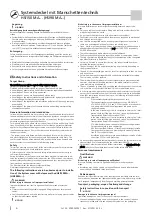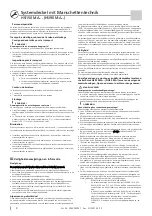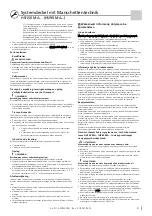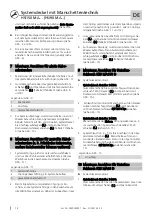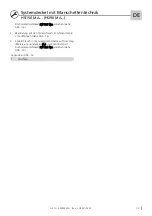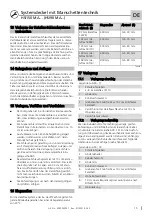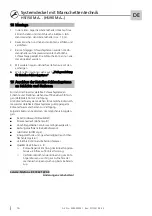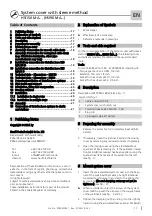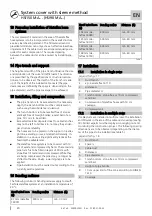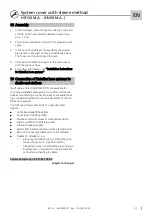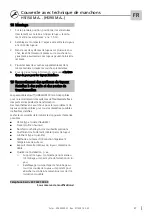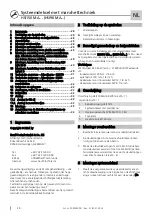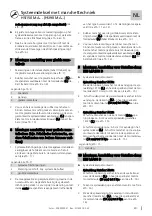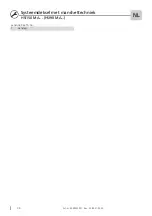
System cover with sleeve method
EN
HSI150 MA... (HSI90 MA...)
20
Réf. art. : 5090030031 Rév. : 01/2021-02-22
13
Preparing installation of Hateflex hose
systems
The compressed fill material in the area of the Hateflex
hose systems is to be incorporated in the overall structure
as a key load-bearing element. The fill material (sand or
gravel/sand mixture) can only act as an effective load-bea-
ring element if the cable ducts are all spaced equally as re-
quired for even compression. The required spacing
between the cable ducts can be ensured by installing spa-
cers.
14
Pipe trench and support
The height and width of the pipe trench influence the size
and distribution of the soil and traffic loads. The dimensi-
ons prescribed by the specifications or structural calcula-
tion are to be observed. The depth of the trench is made
up of the height of the installed cable ducts (the pipe
clearances are defined by the spacers, depending on the
pipe diameter) and the pipe coverage to be achieved.
15
Installation, filling and compression
■
The pipe trench is to be excavated to the necessary
depth; the trench bottom must be compressed in
such a way that subsidence is ruled out.
■
The trench bottom is to be levelled free of stones
and kept free of foreign bodies; a sand bed of ap-
prox. 10 cm is to be added.
■
Excavated material deposited next to cable trenches
may not be left to fall back in, nor may they endan-
ger structural stability.
■
The hoses are to be placed on the support in a strai-
ght line, avoiding curves, and attached laterally. In-
stallation in a sinuous line significantly reduces the
feed depth available later.
■
The Hateflex hose system is to be covered with 10
cm of sand and compressed by hand. The remaining
pipe trench is to be filled in layers of 30 cm with
stone-free fill material and compressed. While they
are being compressed, the pipes may no longer be
shifted to the side. Finally, a warning tape is to be
applied.
■
Pipe installation must be carried out according to the
currently valid regulations.
16
Bending radiuses
The following minimum bending radiuses apply to Hauff-
Technik Hateflex systems at an installation temperature of
20 °C:
Hauff spiral hose
(d)
Bending radius
Distance (A)
87 mm (Hateflex
14078)
400 mm
min. 30 mm
Hauff spiral hose
(d)
Bending radius
Distance (A)
102 mm (Ha-
teflex 14090)
400 mm
min. 30 mm
125 mm (Ha-
teflex 14110)
500 mm
min. 40 mm
140 mm (Ha-
teflex 14125)
600 mm
min. 40 mm
168 mm (Ha-
teflex 14150)
900 mm
min. 40 mm
Table 5
17
Installation
17.1
Installation in single rows
Legend for fig.: 17
1
Duct trench
2
e.g. 4x Hateflex 14110
3
Distance A
4
Pipe diameter d
5
Trench bottom: stone-free or 10 cm compressed
sand bed
6
Compression of Hateflex hoses with 10 cm
coverage
7
Compressed soil
17.2
Installation in multiple rows
If cable ducts are installed in multiple rows, the installation
and fill work in the area of the cable ducts overlap (see fig.
18). Skilled experts must be deployed in carrying out and
monitoring the construction project. The following spacing
dimensions are to be observed, depending on the diame-
ter of the pipes to be installed (see table 5).
Legend for fig.: 18
1
Duct trench
2
Spacers
3
Cable duct
4
Distance A
5
Pipe diameter d
6
Trench bottom: stone-free or 10 cm compressed
sand bed
7
Height of pipe bundle
8
10 cm upper limit of line zone according to DIN EN
1610
9
Coverage

